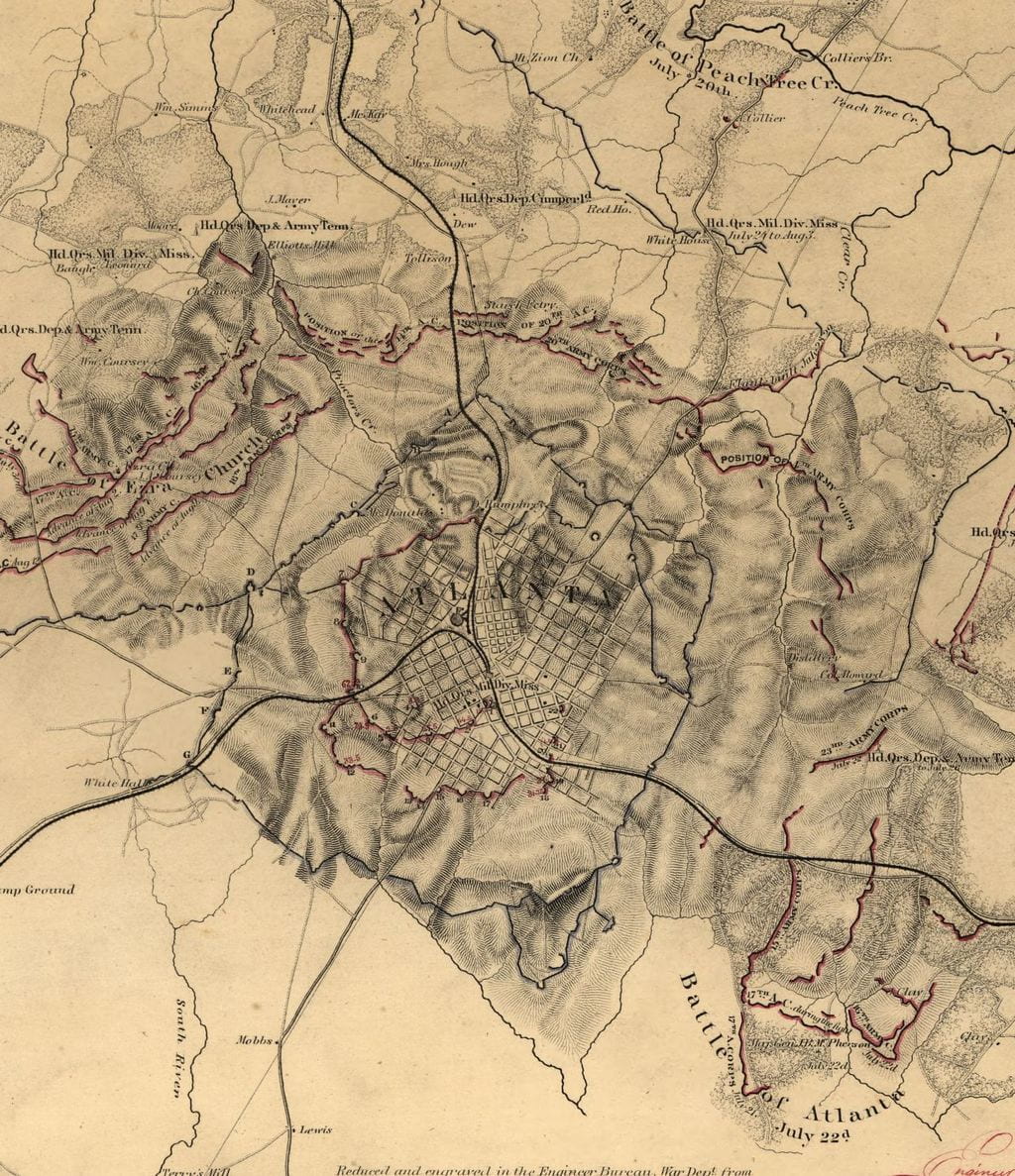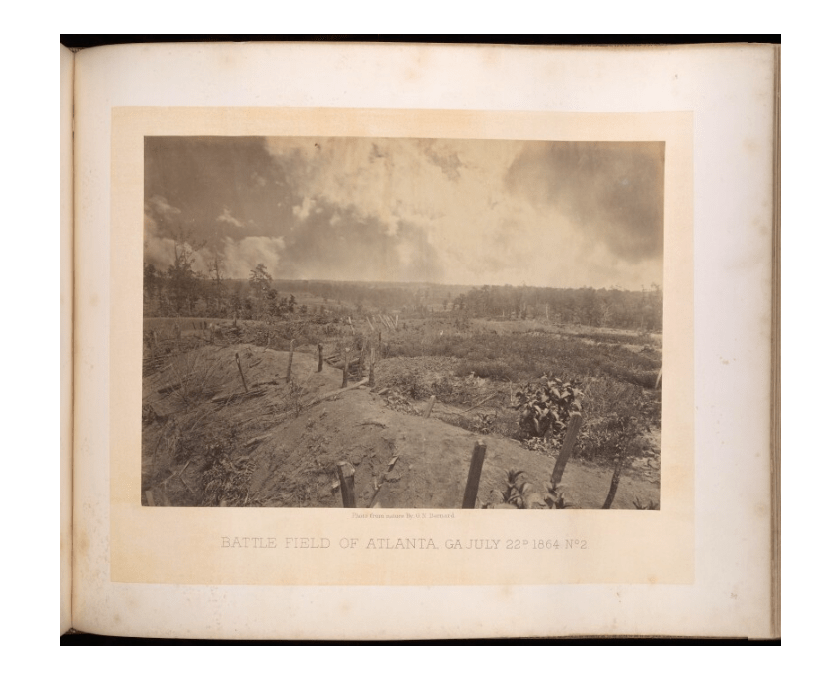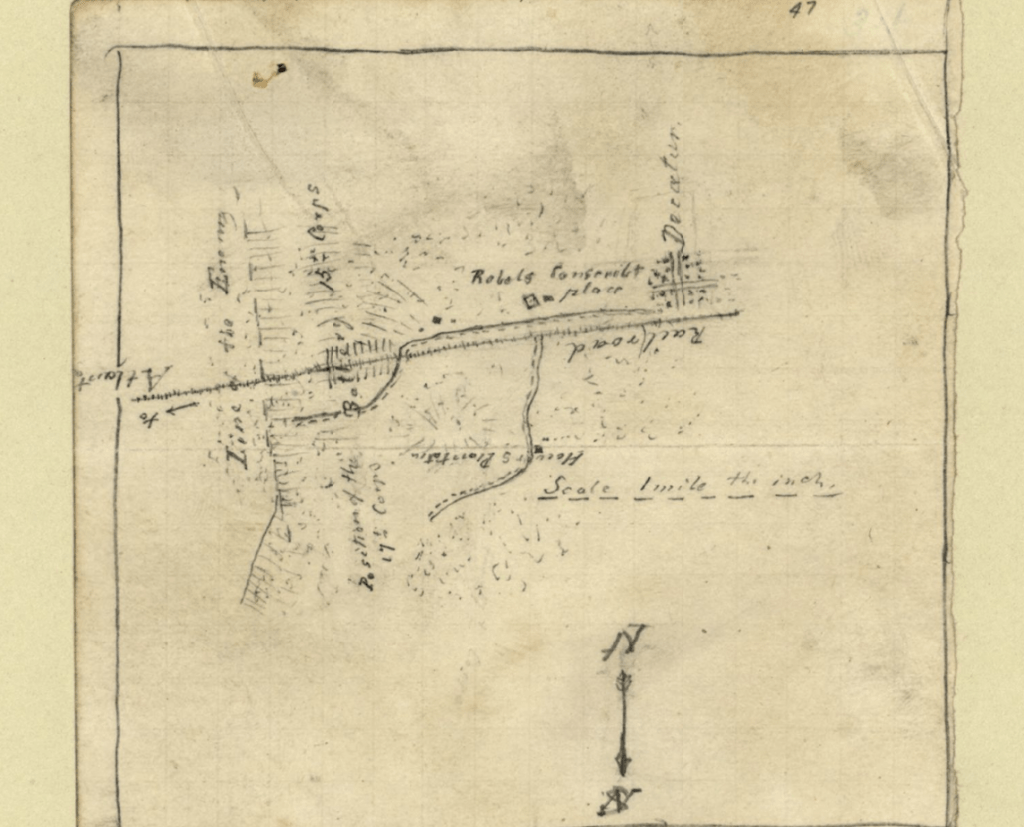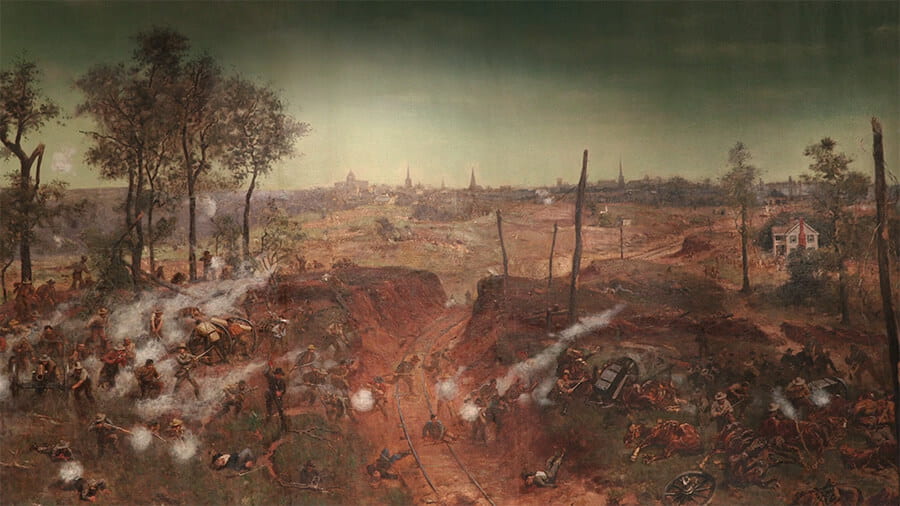In a Time Long Ago…

For many residents of Atlanta’s Eastside, US-23 (or Moreland Avenue) is the backbone of their community. It connects the vibrant cultural hubs of Little Five Points and East Atlanta Village to a myriad of classic Eastside neighborhoods such as Candler Park and East Atlanta. While this route may be a high-traffic residential road today, in 1864 it was little more than undeveloped farmland—unremarkable in every way except its role as the dividing line between Fulton and Dekalb counties. However, as Sherman’s Federal armies made their way towards Atlanta, this undistinguished strip of land would become the site of some of the fiercest fighting experienced by participants of the Atlanta Campaign in the American Civil War. While this clash of arms took place in an area that was, at the time, southeast of the city limits, the action which centered around Federal fortifications at Bald Hill came to be known both to its contemporaries and historians as the Battle of Atlanta. The Battle of Atlanta, though a fierce and bloody contest, would prove inconsequential to the fate of the city and today is a forgotten relic of Atlanta’s past, its historical markers serving as the only testaments to this tremendous folly of war.

Prelude to War
On the eve of secession in 1860, Atlanta was a critical junction of 1200 miles of railroad track which would prove vital to the Confederate war effort. It was a vital hub connecting the Eastern and Western halves of the Confederacy together. Though at the time it was little more than an upstart town in the eyes of Georgia’s older cities, Atlanta became immersed in the pro-secession fervor that swept through the south, and even sent five delegates to the first Confederate Congress in hoped that the rebel government would select the city as it’s seat due to it’s central location and railroads. While the Confederacy would opt not to place their administrative center here, Atlanta’s metalworks and transportation capacity ensure that it would become an important center of southern industry for the duration of the war. By 1864 its strategic importance was second only to that of Richmond, and the Confederacy could not afford to lose its critical infrastructure; If Sherman could take Atlanta, the war in the West was all but lost. 2
Marching Through Georgia

(Note: This map details the situation on the 1st of September, 1864. Atlanta would fall on the 8th.) Image Courtesy of the Library of Congress. 3
In 1864, General William Tecumseh Sherman was given the task of invading Georgia and cutting through the heart of the Confederacy, splitting it in two. His objective was “neither Atlanta, nor Augusta, nor Savannah….[but] the Army of Jos. Johnston, go where it might”. 4 Grant wanted Sherman to keep Confederate General Joseph Johnston busy and prevent him from aiding the rebels in the Eastern Theater.
Sherman marched southward from Chattanooga with 110,000 men towards Atlanta in the spring of 1864. Johnston’s army opposed them every step of the way, fighting battles from Rocky Face Ridge to Kennesaw Mountain. None of these battles were the decisive victories that Sherman was looking for, but he continued to force Johnston to retreat further south. Following their withdrawal from Kennesaw Mountain, Johnston pulled his troops back to the formidable earthworks around Atlanta and set in for a siege. Confederate President Jefferson Davis, weary of Johnston’s defensive posture and delaying tactics, replaced him with the more aggressive John Bell Hood on July 17th, in what would prove to be a critical failure of judgement. 5
The Siege and Peachtree Creek
Rather than attempting an assault on the massive network of fortifications surrounding Atlanta, Sherman decided to besiege the city and it cut it off from the vital railroads that were keeping the Confederates supplied. On July 20th, Federal artillery came into range of Downtown Atlanta. Over the next 36 days they rained 230 tons of explosives and lead over the city’s defenses, equivalent to what 100 B-17 bombers could drop on a city in the Second World War. 6

When asked about the replacement of Gen. Johnston with Gen. Hood by President Davis, Robert E. Lee said “Hood is a bold fighter…..I am doubtful as to other qualities necessary”. 8 Hood would live up to Lee’s concerns during the defense of the city. Choosing to abandon his defenses in favor of a frontal assault, Hood attacked Sherman’s army as they crossed Peachtree Creek roughly five miles North of the city limits. As was the case in most battle in the American Civil War, the advantage lay with the defending party, and the Federals made full use of this. Although the Confederates experienced some success around the present-day location of Bobby Jones Golf Course, they were ultimately rebuffed and pulled back to the city. 9

Hood shifts East
Not to be discouraged by his failure at Peachtree Creek, General Hood redeployed 30,000 the next night. The morning of the 22nd, General Sherman was elated; from all accounts, the rebels had evacuated Atlanta. Assuming that the rebels were scattered on the roads south of the city, he ordered a “vigorous pursuit” of the enemy. 11 His forces obliged, only to find that the Confederates had simply moved to fortifications east of the city limits. A disappointed Sherman set up his command post in a gorgeous white frame house owned by Augustus Hurt (who had recently fled), located just northwest of present day Little Five Points. From here Sherman instructed his subordinate Gen. McPherson to send troops east to destroy the Georgia R.R. line, which ran towards Decatur. McPherson argued against this, fearful of an oncoming Confederate assault on the recently entrenched Federals. Though initially agreeing to stay the order, Sherman ordered McPherson to commence with his original plan around noon. As McPherson sat to write out this order, somewhere northeast of present-day East Atlanta Village, 12,000 Confederate troops under General Bate commenced an attack on the Union’s left flank. 12
The Battle of Atlanta Begins

Hood had ordered Bate to assault the Union left flank and turn it, in order to get behind the Union lines and pave the way for an assault by the rest of his army rather than waiting for Sherman to attack. To his dismay, Bate ran into the experienced Federal 16th Corps commanded by General Dodge. Armed with more repeating rifles than any other unit in the Federal army, Dodge’s men cut the advancing Confederates to ribbons, and Bate’s division began to fall back. 14 To the west, the division of the recently deceased Confederate General Walker similarly stumbled, conducting a poorly coordinated assault that was pushed back. To the left of these failed assaults was Confederate Gen. Cleburne’s division, who had taken a route up Flat Shoals Road that brought him right through a gap in the Union lines, which allowed him to split the Union flank in two. They advanced into the rear of the Union line, and sent skirmishers even further in. These skirmishers came upon the unsuspecting General McPherson and his staff, who was shot by the Confederates as he tried to escape. When asked to identify the deceased General, the lightly wounded Colonel Scott, who had accompanied the General, replied “Sir, it is General McPherson. You have just killed the best man in our army”. 15
Assault on Bald Hill

By this time, Cleburne’s Division had swept northward and driven the Federals back towards the fortified high ground of Bald Hill (roughly where a Texaco is now located at the I-20 West exit off Moreland Avenue), where Gen. Leggett of the Federal 17th Corps was entrenched. Threatened from the east by Cleburne and Gen. Maney’s Division to the West, Leggett’s men dug in and engaged in some of the most desperate and brutal hand-to-hand combat of the war. “Men were bayoneted, knocked down, with the butts of muskets, and even fists were used in default of better weapons in that deadly strife,” wrote Henry Dwight of the 20th Ohio. 17 The fighting on the slopes of Bald hill quickly devolved into a befuddled melee, with the smoke-filled air clouding their vision and the sound of rifle fire and explosions creating a cacophony of noise. Men stripped off their uniform coats to fight in their shirts, making it almost impossible to discern who was on who’s side. 18 Private Sam Watkins of the 1st Tennessee noted in his memoir that “the continued roar of battle sounded like unbottled thunder. Blood covered the ground, and the dense smoke filled our eyes and ears, and faces. The groans of the wounded and dying rose above the Thunder of Battle”. 19 Despite Cleburne’s exploitation of the gap in the Federal lines and the ensuing Confederate assault, the Union soldiers held their positions at the top of Bald Hill.
General Cheatham Attacks

Watching the struggle for Bald Hill from the site of present-day Oakland Cemetery, General Hood ordered his subordinate General Frank Cheatham to conduct a frontal assault on the right flank and center of the Union line, which stretched from the modern-day location of the Variety Playhouse in Little Five Points down past the Edgewood Shopping Center off Moreland Avenue. 21 The Union line had two weak spots; it was pierced by the Georgia R.R. line and a wagon road (roughly where Dekalb Avenue is today) that were left lightly guarded. Cheatham’s men made full use of this and focused their assault at these points. While the assault on the Union center just north of Bald Hill met little success, the attack on the right flank at the aforementioned points managed to punch a hole in the Union line. Confederates were able to seize the Federal fortifications in plain view of General Sherman’s headquarters. Upon seeing this break in the lines, Sherman personally oversaw the placement of Federal cannon on the height just south of the Augustus Hurt House and directed their fire on the Confederate position. The Federals reformed for a counterattack just as reinforcements arrived from their left, led by Gen. Black Jack Logan who famously yelled, “Boys, McPherson and revenge!” Lacking support on their flanks and facing the oncoming Federals, the Confederate left reluctantly withdrew to their original positions. 22

“Twas’ A Picture of Carnage and Death”
So remarked Private Watkins on the aftermath of the battle. 24 The hours-long fight at Bald Hill continued into the early evening, as Cleburne and Maney renewed their assault on the entrenched Union forces. Another melee commenced, with the Confederates slogging through another bout of vicious hand to hand combat “until it grew so dark that nothing could be seen but the flash of the guns”. 25 As Darkness fell, the Rebels slowly withdrew from the hill, using the cover of darkness to carry off their wounded and dead. They initially returned to their starting positions but eventually fell back to their breastworks around the city. The next day, as both armies began to lick their wounds, the appalling human cost became apparent: 3,722 killed, wounded, and missing Federals, with approximately 5000 Confederate casualties. Both sides awoke in the same places they had started. On July 23rd, 1864, modern-day Moreland Avenue was littered with the bodies of the dead and the dying. This ominously foreshadowed the wars of the 20th century and highlighted the folly of a frontal assault on fortified positions equipped with modern weaponry—a lesson that would not be heeded until the unimaginable carnage of the First World War. 26

The Legacy of the Battle of Atlanta
Unlike other Civil War battlefields, the Battle of Atlanta was not preserved and today lies beneath the urban sprawl of Atlanta’s Eastern neighborhoods. During a wave of national support for the preservation of Civil War battlefields in the 1890s, veterans’ organizations ran into Congressional opposition as Congress was reluctant to provide any more Federal funding for the creation of national battlefield parks. While some of the larger, more decisive battles such as Gettysburg and Chickamauga were preserved successfully, the Battle of Atlanta did not make the cut. There was another push to preserve the site in the 1920’s and 30’s, by this point much of the battlefield was already lost to urban expansion. In 1952 the Georgia Historical commission was charged with marking the important events of the battle, and during the centennial of the Civil War in 1961-65, historical markers were placed around the drastically altered terrain. 28 A rather peculiar, yet notable attempt at preserving the legacy of the battle was the Atlanta Cyclorama, which houses the world’s largest oil painting (“The Battle of Atlanta”) that depicts the events of the battle in vivid detail. The painting was completed in 1886 by the American Panorama Company, and debuted in Milwaukee, Wisconsin before being moved to Atlanta in 1892. 29 The painting resided in Grant Park for over a century but was moved to the Atlanta History Center (in Buckhead) in 2017, where it remains accessible to the public.
This is approximately where Bald Hill is today.
Atlanta’s Forgotten Ghost
Despite being the bloodiest battle of the entire Atlanta campaign, the Battle of Atlanta would ultimately prove indecisive; its staggering human cost serving only to weaken the city’s Confederate defenders. General Hood and Sherman would engage in another sortie at the Battle of Ezra Church on July 28th and again at Utoy Creek from August 5th to 7th, before the deciding battle was fought south of the city in Jonesboro from August 31st to September 1st. 30 Hood’s aggressive tactics at the Battle of Atlanta and the ensuing engagements cost him 20,000 troops that he could not replace, and ultimately forced him to withdraw from the city on September 8th. 31 Atlanta was occupied by General Sherman, and the city was infamously burnt to deprive the Confederacy of anything that could further their war effort as Sherman embarked on his March to the Sea. The fall of Atlanta effectively ended the Confederacy’s ability to successfully conduct offensive operations in the Western Theater and ended any hope they had of victory in the war. Tragically, the war would drag on until April of 1865. Today, the hallowed ground on Moreland Avenue where so many Americans perished, both blue and grey, is covered by residential housing, gas stations, stores and cultural attractions. Nothing remains of the hellish day they endured on the slopes of Bald Hill but some scattered historical markers, and the written accounts of those who fought there.

First Image: O. Poe, William Sherman, E. Molitor, Richard Dolafield, and the United States War Department, Map illustrating the siege of Atlanta, Ga., by the U.S. forces under command of Maj. Gen. W.T. Sherman, from the passage of Peach Tree Creek, July 19th 1864, to the commencement of the movement upon the enemy’s lines of communication south of Atlanta, 1865, https://www.loc.gov/resource/g3924a.cws00039/?st=image&r=0.264,0.018,0.77,0.622,0.
- George Barnard, Atlanta, Ga. View on Whitehall Street, 1864, https://loc.gov/resource/cwpb.03466/. ↩
- Lee Kennett, Marching Through Georgia: The Story of Soldiers & Civilians During Sherman’s Campaign (New York: HarperCollins, 1995), 112, 113, 114. ↩
- Robert Sneden, Atlanta Georgia and its rebel defences sic, 1864-1865, https://www.loc.gov/resource/gvhs01.vhs00311/?r=-0.342,-0.071,1.773,1.432,0. ↩
- William Sherman, Memoirs of General W.T. Sherman, Volume 2 of 2 (New York: Nova Science, 2018), 117. https://web.p.ebscohost.com/ehost/detail/detail?vid=0&sid=cbc71827-263a-4c76-8cb9-fdd3847a3062%40redis&bdata=JkF1dGhUeXBlPWlwLHNoaWImc2l0ZT1laG9zdC1saXZlJnNjb3BlPXNpdGU%3d#AN=2000461&db=e000xna ↩
- Ashlyn Still, “War in our Backyards”, Atlanta Journal Constitution. https://battleofatlanta.ajc.com/ (Accessed April 8th, 2022). ↩
- Still, “War in Our Backyards”. ↩
- George Barnard, Atlanta, Ga. Gen. William T. Sherman, leaning on breach of gun, and staff at Federal Fort No. 7, 1864, https://www.loc.gov/resource/cwpb.03384/. ↩
- David A. Pollock, “The Battle of Atlanta: History and Remembrance”, Southern Spaces. https://southernspaces.org/2014/battle-atlanta-history-and-remembrance/ (accessed April 11th, 2022). ↩
- Still, “War in our Backyard”. ↩
- View from Confederate lines south-east of Atlanta, Ga., 1861-1865, https://www.loc.gov/resource/ppmsca.32750/. ↩
- Russell Bonds, War Like the Thunderbolt: The Battle and Burning of Atlanta. (Yardley: Westholme, 2010), 141. ↩
- Ibid, 142-144. ↩
- O. Poe, William Sherman, E. Molitor, Richard Dolafield, and the United States War Department, Map illustrating the siege of Atlanta, Ga., by the U.S. forces under command of Maj. Gen. W.T. Sherman, from the passage of Peach Tree Creek, July 19th 1864, to the commencement of the movement upon the enemy’s lines of communication south of Atlanta, 1865, https://www.loc.gov/resource/g3924a.cws00039/?clip=4436,2772,1666,1158&ciw=882&rot=0. ↩
- Ibid, 147. ↩
- Ibid, 145-154. ↩
- Matthew Brady, George Barnard, Battlefield of Atlanta, GA, July 22, 1864, https://repository.duke.edu/dc/barnardgardner/barsi01001. ↩
- Henry Dwight, “How we fight at Atlanta”, Harper’s New Monthly Magazine. October 29, 1864, 666. ↩
- Bonds, War like the Thunderbolt, 159. ↩
- Sam Watkins, Co. Aytch: A Civil War Narrative. (Scotts Valley: CreateSpace, 2013), 133. ↩
- McPherson, Map of the battle of Atlanta, Georgia, July 22, 1864, July 22, 1864, https://www.loc.gov/resource/g3924d.cws00041/?r=-0.037,0.027,1.062,0.858,0. ↩
- “Where Hood Watched the Battle of Atlanta.” The Historical Marker Database. https://www.hmdb.org/m.asp?m=10448 (Accessed April 27, 2022). ↩
- Bonds, War Like the Thunderbolt, 163-169. ↩
- Heine, Freidrich, “The Battle of Atlanta”, Oil Painting, 1886, Atlanta History Center, https://southernspaces.org/2014/battle-atlanta-history-and-remembrance/. ↩
- Watkins, Co. Aytch, 134. ↩
- Bonds, War Like the Thunderbolt, 169. ↩
- Ibid, 169-172. ↩
- Heine, Freidrich, “The Battle of Atlanta”, Oil Painting, 1886, Atlanta History Center, https://southernspaces.org/2014/battle-atlanta-history-and-remembrance/. ↩
- Daniel A. Pollock, “The Battle of Atlanta: History and Remembrance.” Southern Spaces. https://southernspaces.org/2014/battle-atlanta-history-and-remembrance/. May 30, 2014. (Accessed April 27, 2022). ↩
- “Cyclorama: The Big Picture.” Atlanta History Center. https://www.atlantahistorycenter.com/exhibitions/cyclorama/. (Accessed April 28, 2022). ↩
- Still, “War in our Backyards”. ↩
- Bonds, War like the Thunderbolt, 397. ↩
- Anonymous, Blue and Gray Beautifully Intertwined, July 20, 1900, https://southernspaces.org/2014/battle-atlanta-history-and-remembrance/. ↩
